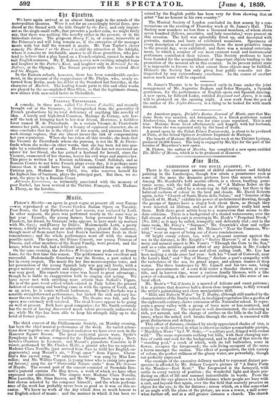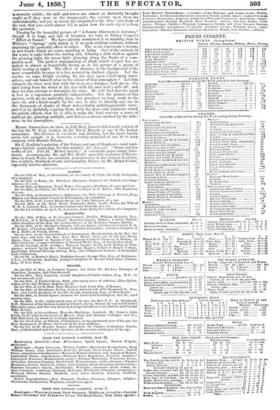JiUt 3.rts.
EXHIBITION OF THE ROYAL ACADEMY. IV.
There is the customary amount of skilful observation and faithful painting in the Landscapes, though few attain a prominence such as some of the more the dramatic pictures have this season achieved. Among Mr. Stanfield's bold marine effects, is a clever, bustling, pano- ramic scene, with the full dashing sea, of "A Maltese.Xebee on the Rocks of Procida," aided by a steam-tug in full swing; but there is the habitual coolness of colour in the land and clouds. Mr. David Roberts again, in his "Church of Santa Maria della Salute," and "Interior of the Church of St. Mark," exhibits his power of architectural drawing, though the groups of figures have a stagey look about them, as though they were inserted ad libitum, and not as if the painter really had seen them. Both these great artists keep to a mannerism that seems to dis- dain criticism. There is a background of a shaded watercourse, over the full stream of which a cart is crossing in Mr. Hook's "Perpetual Brook," (No. 2500 as it may be called, tranquilly and delicately real ; and in the same room, Mr. Percy's "Summer," Mr. Creswiek's clear and rather cold "Coming Summer," and Mr. Holmes's "Near the Common, Wo- king," wear an aspect of being out of doors reminiscences.
Of bright sunny colour, too, with a pleasant contrast against the sea in the distance, is Mr. Knight's "Barley Harvest "; of a like sum- mery and natural aspect is Mr. Fenn's "Through the Corn to the Sea," and as a calm antidote against effort of any description is Mr. Cooke's "Venice," with the still water and silent sailing craft. Mr. Lee has been making a stride since last year : both his "Coast of Cornwall, near the Land's End," and "Bay of Biscay," disclose a poet's sympathy with the turbulence of the sea, its grand anger, and solemn masses of deep water. The three landscapes by Mr. Linnell and his two sons, being various presentments of a corn field under a thunder shower, at even- tide, and in harvest time, wear a curious family likeness, with a like power of colouring, a like amount of painstaking, and a like sense of na- tural effect.
Mr. Brett's "Val &Aosta is a marvel of delicate and exact patience; it is a picture that deserves half a dozen close inspections, to fitly reward the artist's painstaking and clean manipulative skill.
"Hills and Dales in Wales" by T. Denby, although still marked by the characteristics of the Denby school, in its clipped vegetation like a garden of the eighteenth century, shows extension of the Naturalist school. It repre- sents a grassy valley with a group of trees more or less scattered, and hills in the distance. The texture is well discriminated, the colouring is rich, yet natural, and the change of surface on the hills in the half dis- tance, where the naked rock breaks through the earth, is executed with great distinctness and delicacy. This effect of distance' obtained by nicely appreciated shades of tint, is scarcely so well observed in what is otherwise rather a remarkable picture, " Marshllyn Mawr" byJ. W. Oaks,—" a solitary pool, fringed with rushes wild." The scene represents nothing but hills, with their changing sur- face of earth and rock for the background, and in front of that screen the "standing pool," a creek of which, with its tall bullrushcs, some in flower, occupies the foreground ; the sole living occupant of the scene a heron amongst the rushes. The effect of perspective, the rich variety of colour, the perfect stillness of the glassy water, are powerfully, though not perfectly expressed.
One example of the excessive delicacy needed to represent distant per- spective is afforded by Mr. Sidney Cooper's picture of "A Dairy Farm in the Marshes—East Kent." The foreground is the farmyard, with cattle in every variety of position ; the wonderful light and shade pro- ducing an effect of life and summer indescribable in words. From the foreground the eye glances to a half-distance where people are busy with a cart, and beyond that again, over the flat field that scarcely presents an object for the eye, to the far distance ; across which, on a line somewhat at an angle with the plane of the picture, are seen a tower, a mill some- what further off, and at a still greater distance a church. The church la scarcely visible; the mill and tower are almost as distinctly brought ought as if they were in the foreground ; the colours upon them are unmistakeable, and yet so nicely discriminated is the force and shade of the tint, that you could almost tell in miles how far each object is from the spectator.
Passing by the beautiful picture of "A Sunny Afternoon in Autumn," though it is large and full of beauties, we turn to Sidney Cooper's "Effect at Sunset." We have already mentioned it as standing close to Millais's "Spring" with which it is in such striking contrast, without impairing the powerful effect of either. The scene represents a stream, in and beside which are cows, standing or lying. One of the animals in the water is right before the setting sun, forming a dark shadow against the glowing light, the warm light glancing along the flanks of a com- panion near. The perfect transparency of shade which Cooper has ac- quired is almost as beautifully shown as in his picture of a group of cattle resting at night. The effect of distance in the background is the more remarkable because it is less assisted by distinct objects. Let the reader, on some bright evening, fix his eyes upon a half misty atmo- sphere, and ask himself what is the colour of that atmosphere ? Let him compare the trees near him with the trees at a distance, both green ; the mist rising from the water at his feet with the mist half a mile off; and then let him attempt to determine the tints. He will find that the mind is lost in a vagueness painfully indescribable. Yet the painter of this picture, with an eye naturally keen, but practised by long study in the open air, and a hand taught by the eye, is able to identify any one in the thousands of shades of those indescribably indistinguishable tints ; and it is by faithfully copying them, with the gross rude pigments which his palette affords, that he is able to make the hard canvass a scene of ambient air, glancing sunlight, and distances almost marked by the mile- stone in the atmosphere.



























 Previous page
Previous page